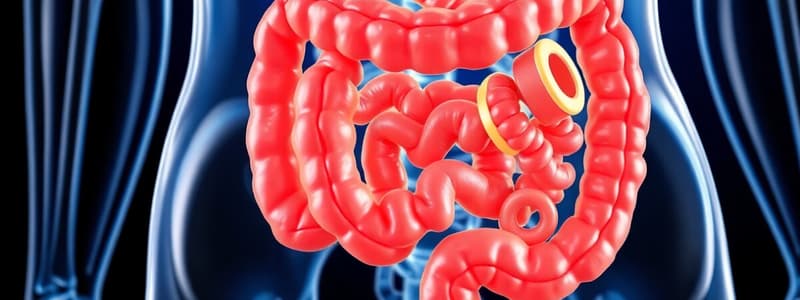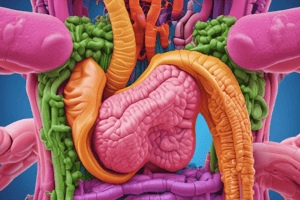Podcast
Questions and Answers
What is the primary function of bile in the digestive process?
What is the primary function of bile in the digestive process?
- To break down carbohydrates into sugars
- To absorb water and electrolytes
- To emulsify fats for easier digestion (correct)
- To transport nutrients in the bloodstream
What role do the epithelial cells in the small intestine play?
What role do the epithelial cells in the small intestine play?
- Transporting waste materials out of the body
- Generating digestive enzymes for carbohydrate breakdown
- Producing bile for fat digestion
- Facilitating nutrient absorption through specialized transport proteins (correct)
Which layer of the small intestine is responsible for peristalsis and segmentation?
Which layer of the small intestine is responsible for peristalsis and segmentation?
- Mucosa
- Submucosa
- Serosa
- Muscularis externa (correct)
How are proteins absorbed in the small intestine?
How are proteins absorbed in the small intestine?
What is the primary function of the large intestine?
What is the primary function of the large intestine?
Which section of the small intestine is primarily responsible for the absorption of most nutrients?
Which section of the small intestine is primarily responsible for the absorption of most nutrients?
What role do villi and microvilli play in the small intestine?
What role do villi and microvilli play in the small intestine?
Which accessory organ produces bile to aid in fat digestion?
Which accessory organ produces bile to aid in fat digestion?
What type of digestion begins in the mouth?
What type of digestion begins in the mouth?
How does gastric juice contribute to digestion in the stomach?
How does gastric juice contribute to digestion in the stomach?
What is the process called that moves food through the esophagus to the stomach?
What is the process called that moves food through the esophagus to the stomach?
What type of nutrients does the pancreas help digest?
What type of nutrients does the pancreas help digest?
What is the primary function of proteases in digestion?
What is the primary function of proteases in digestion?
Which best describes the role of amylases in the digestive process?
Which best describes the role of amylases in the digestive process?
Which mechanism is involved in the absorption of amino acids in the small intestine?
Which mechanism is involved in the absorption of amino acids in the small intestine?
What is the function of bile during digestion?
What is the function of bile during digestion?
Which statement accurately describes the small intestine's anatomy?
Which statement accurately describes the small intestine's anatomy?
What role do the brush border enzymes play in nutrient digestion?
What role do the brush border enzymes play in nutrient digestion?
Which type of diffusion allows small, non-polar molecules to pass through the intestinal lining?
Which type of diffusion allows small, non-polar molecules to pass through the intestinal lining?
How does nutrient assimilation differ from mere absorption?
How does nutrient assimilation differ from mere absorption?
Flashcards
Bile's role in fat digestion
Bile's role in fat digestion
Bile breaks down fats into smaller droplets, increasing surface area for enzyme action.
Large Intestine absorption
Large Intestine absorption
Absorbs water and electrolytes from undigested food, creating feces.
Small Intestine Mucosa
Small Intestine Mucosa
Inner lining with folds (plicae circulares), villi and microvilli for nutrient absorption.
Nutrient Absorption in Small Intestine
Nutrient Absorption in Small Intestine
Signup and view all the flashcards
Small Intestine Layers
Small Intestine Layers
Signup and view all the flashcards
Small Intestine Function
Small Intestine Function
Signup and view all the flashcards
Small Intestine Structure
Small Intestine Structure
Signup and view all the flashcards
Duodenum Function
Duodenum Function
Signup and view all the flashcards
Jejunum Function
Jejunum Function
Signup and view all the flashcards
Ileum Function
Ileum Function
Signup and view all the flashcards
Villi and Microvilli
Villi and Microvilli
Signup and view all the flashcards
Digestive System Role
Digestive System Role
Signup and view all the flashcards
Accessory Organs
Accessory Organs
Signup and view all the flashcards
Enzyme Role in Digestion
Enzyme Role in Digestion
Signup and view all the flashcards
Amylase's Function
Amylase's Function
Signup and view all the flashcards
Lipase's Function
Lipase's Function
Signup and view all the flashcards
Protease's Function
Protease's Function
Signup and view all the flashcards
Small Intestine's Role
Small Intestine's Role
Signup and view all the flashcards
Simple Diffusion
Simple Diffusion
Signup and view all the flashcards
Facilitated Diffusion
Facilitated Diffusion
Signup and view all the flashcards
Study Notes
Small Intestine Structure
- The small intestine is a long, highly folded tube that is the primary site of nutrient absorption in the digestive system.
- Its length and structure maximize surface area for absorption.
- The small intestine is divided into three sections: duodenum, jejunum, and ileum.
- The duodenum is the first part, receiving chyme (partially digested food) from the stomach and secretions from the pancreas and liver.
- The jejunum is the middle section, where most nutrient absorption occurs.
- The ileum is the final section, absorbing remaining nutrients and sending the indigestible material to the large intestine.
- Villi and microvilli greatly increase the surface area of the small intestine lining.
- Villi are finger-like projections, while microvilli are tiny hair-like projections on the surface of the villi.
- These structures dramatically increase the amount of surface area available for nutrient absorption.
- The intestinal lining is specialized for absorption, with cells containing enzymes and transport proteins necessary for nutrient uptake.
Digestive System Overview
- The digestive system is a complex group of organs responsible for the process of breaking down food into smaller molecules that the body can absorb and use for energy and growth.
- Food is ingested, mechanically and chemically broken down, absorbed, and the waste products are eliminated.
- The digestive system consists of the alimentary canal (a continuous tube from the mouth to the anus) and accessory organs.
- Accessory organs include the salivary glands, pancreas, liver, and gallbladder, which produce secretions crucial for digestion.
- The mouth is the initial site of digestion where food is mechanically broken down by chewing (mastication) and moistened by saliva.
- Saliva contains enzymes that initiate the chemical breakdown of carbohydrates.
- The esophagus carries swallowed food to the stomach via peristalsis.
- The stomach stores food, mechanically mixes it with gastric juices, and initiates protein digestion.
- Gastric juices include hydrochloric acid and enzymes like pepsin.
- The stomach's muscular walls churn the food, creating chyme.
- The pancreas produces enzymes for digestion of carbohydrates, proteins, and fats and bicarbonate to neutralize stomach acid.
- The liver produces bile, which is stored in the gallbladder and aids in the digestion and absorption of fats.
- Bile emulsifies fats, breaking them into smaller droplets, increasing the surface area for enzyme action.
- The large intestine absorbs water and electrolytes from the undigested material, forming feces.
Structure of the Small Intestine (details)
- The mucosa is the inner lining, composed of folds (plicae circulares).
- Epithelial cells lining the villi and microvilli contain specialized transport proteins for nutrient absorption.
- The small intestine's submucosa contains blood vessels (capillaries) and lymphatic vessels (lacteals) for nutrient transport.
- The muscularis externa is responsible for peristalsis and segmentation to move and mix chyme along the intestine.
- The serosa is the outermost layer, a protective membrane.
- Each layer has a specialized function that supports the overall process of digestion and absorption in the small intestine.
Importance of Absorption Mechanisms
- Different nutrients are absorbed through specific mechanisms within the small intestine.
- Carbohydrates are absorbed as monosaccharides (e.g., glucose).
- Proteins are absorbed as amino acids.
- Fats are absorbed as fatty acids and glycerol.
- Vitamins and minerals are absorbed through various transport mechanisms.
- Absorption mechanisms are crucial for providing the body with essential nutrients for energy and cellular functions.
Studying That Suits You
Use AI to generate personalized quizzes and flashcards to suit your learning preferences.




